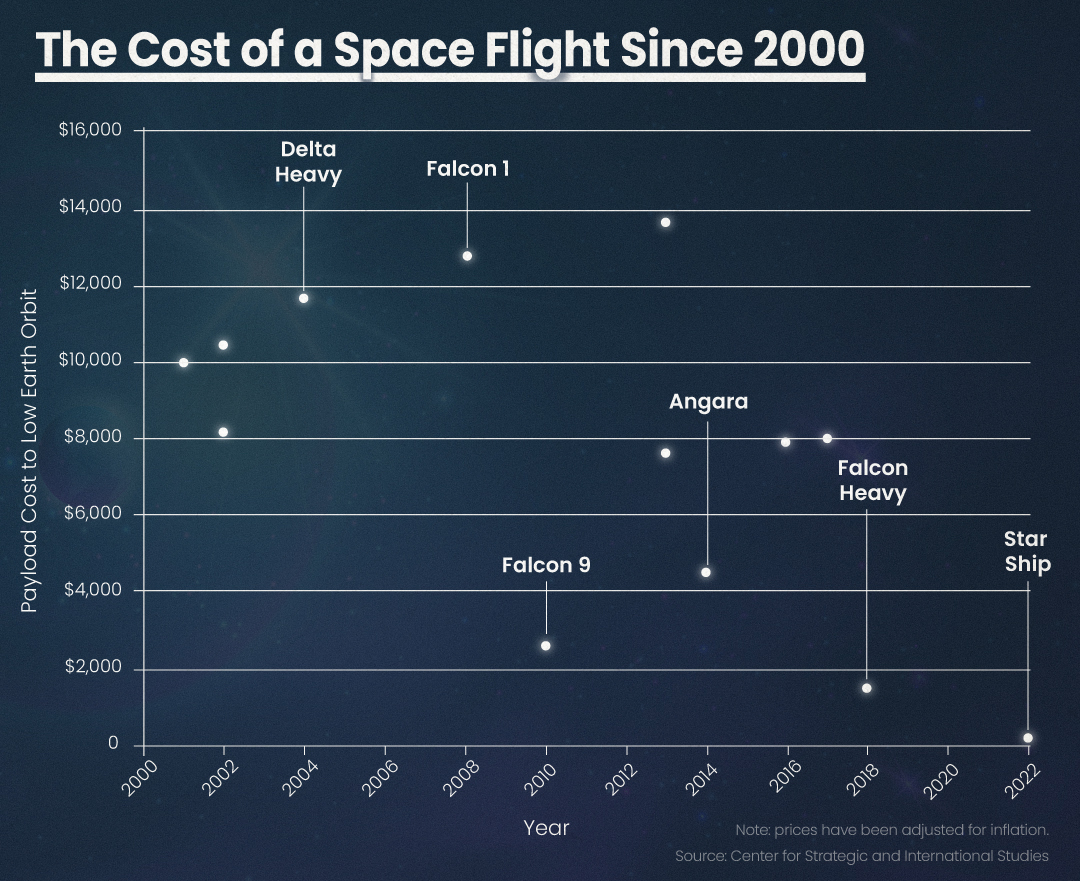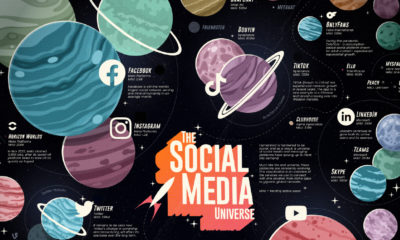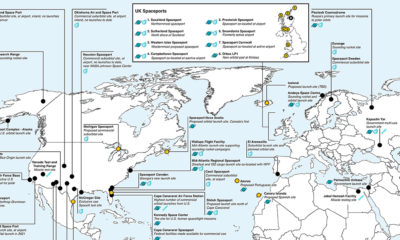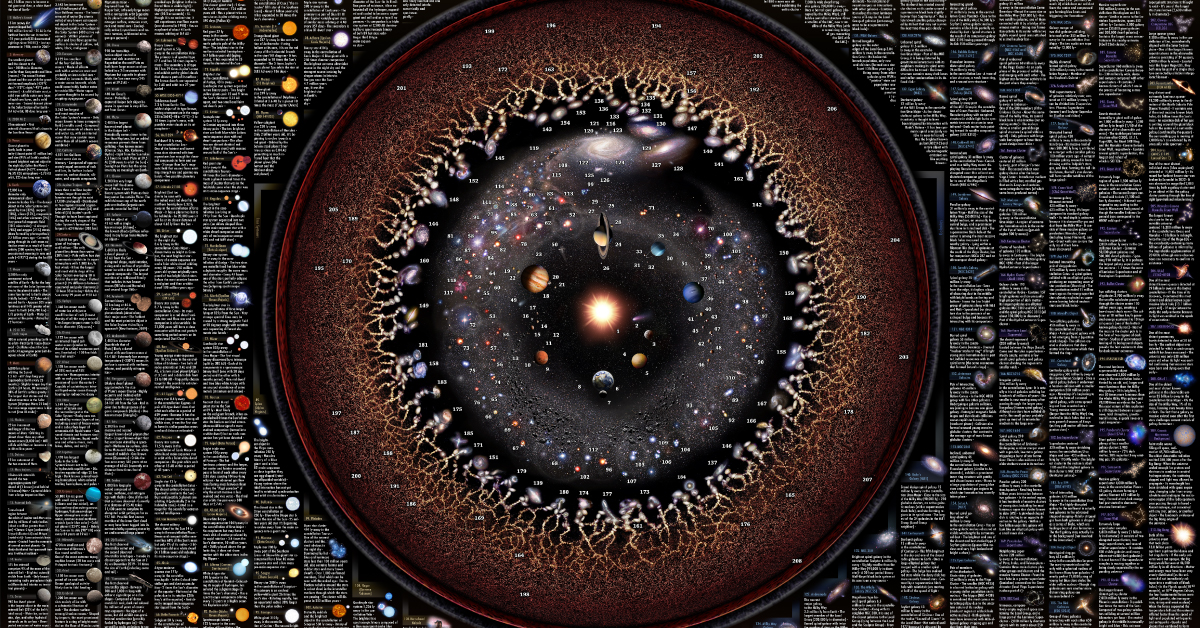Just eight minutes after liftoff, the rocket’s first stage returned to Earth, landing on one of SpaceX’s drone ships in the Atlantic Ocean. This marked the company’s 100th successful landing. Like other companies such as Jeff Bezos’ Blue Origin, and Ball Aerospace, SpaceX is designing and building innovative spacecraft that are speeding up space delivery by making it more routine and affordable. But how much does it cost to launch a cargo rocket into space, and how has this cost changed over the years? In the graphic above we take a look at the cost per kilogram for space launches across the globe since 1960, based on data from the Center for Strategic and International Studies.
The Space Race
The 20th-century was marked by competition between two Cold War adversaries, the Soviet Union (USSR) and the United States, to achieve superior spaceflight capability. The space race led to great technological advances, but these innovations came at a high cost. For instance, during the 1960s NASA spent $28 billion to land astronauts on the moon, a cost today equating to about $288 billion in inflation-adjusted dollars. In the last two decades, space startup companies have demonstrated they can compete against heavyweight aerospace contractors as Boeing and Lockheed Martin. Today, a SpaceX rocket launching can be 97% cheaper than a Russian Soyuz ride cost in the ’60s.
The key to increasing cost efficiency? SpaceX rocket boosters usually return to Earth in good enough condition that they’re able to be refurbished, which saves money and helps the company undercut competitors’ prices.
Space Tourism
Although competition has brought prices down for cargo flights, human space transportation is still pricey. During the last 60 years, roughly 600 people have flown into space, and the vast majority of them have been government astronauts. For a suborbital trip on Virgin Galactic’s SpaceShipTwo and Blue Origin’s New Shepard, seats typically cost $250,000 to $500,000. Flights beyond that to actual orbit—a much higher altitude—are far more expensive, fetching more than $50 million per seat.
The Future of Space Flight
In a SpaceX press briefing, SpaceX Director Benji Reed said, “We want to make life multi-planetary, and that means putting millions of people in space.” This may still seem like a stretch for most people. But, given the decreasing cost of space flights over the last two decades, perhaps the sky won’t be the limit in the near future. on And while we haven’t figured out all the answers quite yet, we’ve made some remarkable discoveries when it comes to learning about outer space. What are some of the most notable observations that scientists have discovered so far? This map of outer space by Pablo Carlos Budassi highlights more than 200 celestial objects in our universe and provides details and facts about each one.
The Types of Celestial Objects Mapped
To create this graphic, Budassi used a combination of logarithmic astronomical maps from Princeton University, as well as images from NASA. The visualization highlights 216 different celestial objects that are color-coded and organized into five overarching categories:
Moons and Asteroids Planets Galaxies Star System Great Scales/Superclusters
At the center of the map is the Sun, which is the largest object in our Solar System. According to NASA, the Sun’s volume is equivalent to 1.3 million Earths. The Sun is the powerhouse of life here on Earth—its energy provides our planet with a mild, warm climate that keeps us alive, keeping the Earth from becoming a frozen rock. While the Sun is the only star in the Solar System, there is a neighboring star system called Alpha Centauri that’s approximately 4.37 light-years away. It’s made up of three stars—Proxima Centauri, Alpha Centauri A, and Alpha Centauri B. Proxima Centauri, as the Latin name indicates, is the closest of the three to Earth and has an Earth-sized planet in its habitable zone.
The Life of a Star
In a star’s early stages, it’s powered by hydrogen. However, when its hydrogen stores are depleted, some stars are able to fuse helium or even heavier elements. Stars similar to the size of the Sun will grow, cool down, and eventually transform into a red giant. The Sun has about 5,000 million more years before it reaches its red giant stage, but when that happens, it will likely expand to the point where it swallows up the Earth. While stars emit energy for years, it’s important to note that they don’t shine for eternity. Their exact life span depends on their size, with bigger stars burning out faster than their smaller counterparts. But as light from distant objects millions of light-years away takes a long time to reach us here on Earth, the largest of stars shine for hundreds of millions of years after they die.
Just How Big is Our Universe?
Some experts believe that the universe is infinite, while others argue that we can’t yet know for certain because current measurements aren’t accurate enough. However, scientists believe that our observable universe extends about 46 billion light-years in every direction, giving it a diameter of roughly 93 billion light-years. But just how much of the universe extends beyond what we can see? We may never find out.














